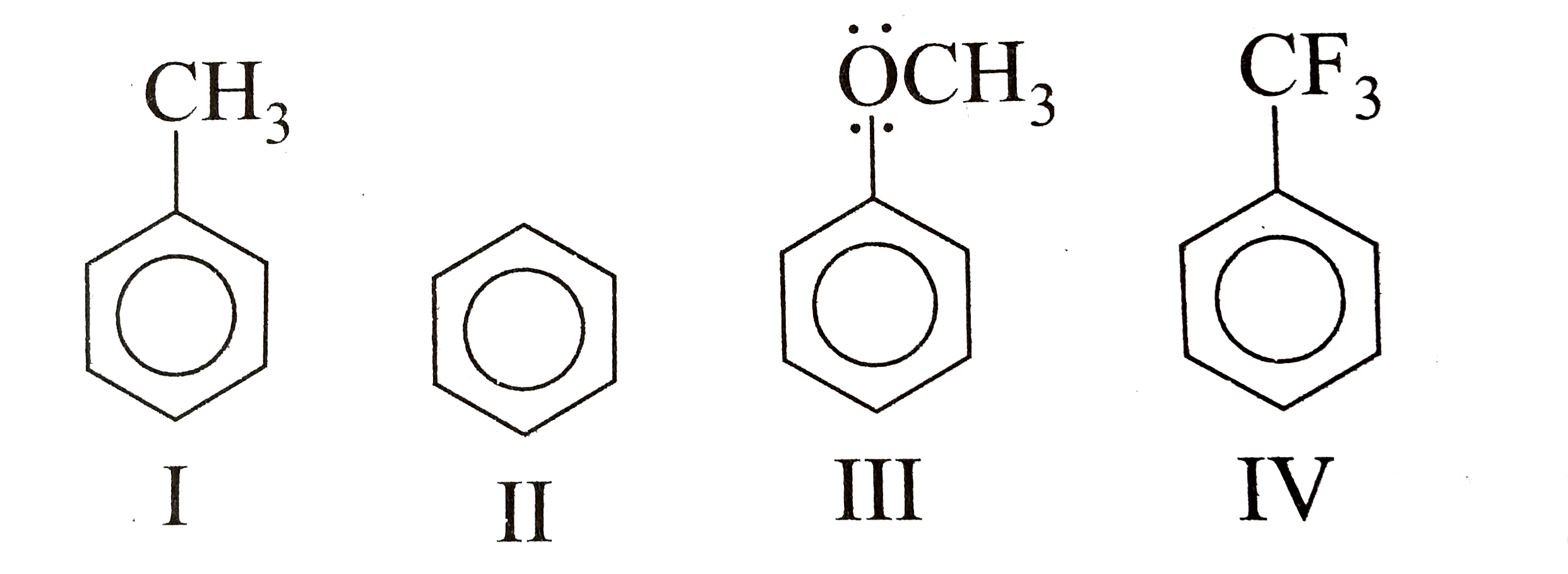Arrange the following set of compounds in the order of their decreasing relative reactivity with an electrophile. Give reasons.

The methoxy group (−OCH3) is electron releasing group and increases electron density

Electron density of benzene ring due to +R effect. Hence it makes anisole more reactive than benzene.
Incase of Cl group it gives -I effect and +R effect. Its reactivity is less than methoxy benzene.
−NO2 group gives -I effect and -R effect, So it is less reactive than chloro benzene.

Topper's Solved these Questions
- HYDROCARBONSBOOK - KUMAR PRAKASHANCHAPTER - HYDROCARBONSEXERCISE - Section - D (NCERT Exemplar Solution) (Matching type Columns)
4 Videos
- HYDROCARBONSBOOK - KUMAR PRAKASHANCHAPTER - HYDROCARBONSEXERCISE - Section - D (NCERT Exemplar Solution) (Assertion and Reason Type)
4 Videos
- HYDROCARBONSBOOK - KUMAR PRAKASHANCHAPTER - HYDROCARBONSEXERCISE - Section - D (NCERT Exemplar Solution) (Multiple choice Questions (MCQs) (More than one correct answer))
9 Videos
- EQUILIBRIUMBOOK - KUMAR PRAKASHANCHAPTER - EQUILIBRIUMEXERCISE - Question Paper from Module
7 Videos
- HYDROGENBOOK - KUMAR PRAKASHANCHAPTER - HYDROGENEXERCISE - Section-D NCERT Exemplar (Long Answer)
8 Videos
Similar Questions
Arrange the following set of compounds in order of their decreasing relative reactivity with an electrophile, E+
(a) Chlorobenzene, 2,4-dinitrochlorobenzene, p-nitrochlorobenzene
(b) Toluene, p−H3C–C6H4–NO2,p−O2N–C6H4–NO2.
View SolutionArrange the following set of compounds in order of their decreasing relative reactivity with an electrophile, E+
(a) Chlorobenzene, 2,4-dinitrochlorobenzene, p-nitrochlorobenzene
(b) Toluene, p−H3C–C6H4–NO2,p−O2N–C6H4–NO2.
View Solution
Knowledge Check
Arrange the following set of compounds in the order of their decreasing relative reactivity with an electrophileE+
I.Chlorobenzene
II.2,4 dinitrochlorobenzene
III.P-nitrochlorobenzene
IV.toluene V.p−H3C−C6H4−NO2AI>II>III>IV>VBIV>V>I>III>IICV>IV>III>II>IDI>III>II>V>IVArrange the following set of compounds in order of their decreasing relative reactivity with an electrophile, E+
(a) Chlorobenzene, 2,4-dinitrochlorobenzene, p-nitrochlorobenzene
(b) Toluene, p−H3C–C6H4–NO2,p−O2N–C6H4–NO2.A(iii)>(ii)>(i)B(ii)>(iii)>(i)C(i)>(iii)>(ii)D(i)>(ii)>(iii)Arrange the following compounds in order of their decreasing reactivity with an electrophile,E(+)
i) Chlorobenzene
ii) 2,4- dinitrochlorobenzene
iii)p- nitrochlorobenzeneAC gt B gt ABB gt C gt ACA gt C gt BDA gt B gt C
Arrange the following set of compounds in order of their decreasing relative reactivity with an electrophile, E+
(a) Chlorobenzene, 2,4-dinitrochlorobenzene, p-nitrochlorobenzene
(b) Toluene, p−H3C–C6H4–NO2,p−O2N–C6H4–NO2.
View SolutionArrange the following compounds in order of their decreasing reactivity with an electrophile,E(+)
i) Chlorobenzene
ii) 2,4- dinitrochlorobenzene
iii)p- nitrochlorobenzene
View SolutionArrange the following in decreasing order of their reactivity with an electrophile.

View SolutionArrange the following in decreasing order of their reactivity with an electrophile.

View Solution
Among the compounds the order of decreasing reactivity towards electrophilic substitution is
View Solution
